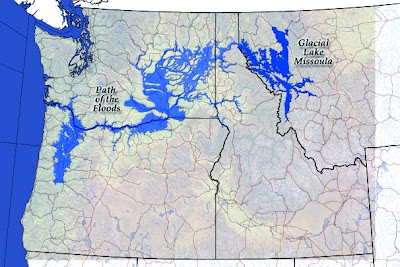
MAP. "A visual representation of an area -- a symbolic depiction highlighting relationships between elements of that space, such as objects, regions, or themes." Maps can be static or interactive, flat or three dimensional, and can vary in scale and accuracy. My interest today is in geological maps, as opposed to DNA maps, brain maps, or star maps. Here is a small sampling of map types and their uses:
~ Aeronautical charts - maps designed to assist in the navigation of aircraft.
~ Cartograms - maps in which thematic variables (e.g., population) are compared.
~ Contour maps - maps in which contour lines show the gradients in variables such as barometric pressure, temperatue, wind speed and direction.
~ Fantasy maps - maps showing an imaginary geography, notably in books of fiction.
~ Floor plans - maps showing the dimensions and relationships of rooms in a house.
~ Geologic maps - maps showing the geologic features (rock stata, faults) of an area.
~ Nautical charts - maps designed to assist in the navigation of watercraft.
~ Pictorial maps - maps more artistic than technical, often presenting the buildings, streets and historical attractions of a particular city or region.
~ Plats - maps drawn to scale, showing the property divisions of an area of land.
~ Topographic maps - maps showing large scale terrain features and variations in elevation.
~ World maps - maps depicting the surface of the Earth, using a variety of projections.
The above list only scratches the surface (so to speak). I've loved maps as far back as I can remember. Like books and movies, maps are windows onto other places, other times. Their variety is endless. And now, with tools such as Google Maps or Google Earth, one can explore anywhere, in two or three dimensions, manipulating magnification and feature options for a near-addictive experience.
Here are a few of my favorite online map resources, in no particular order:
~ ranked areas of US states (chart form)
~ ranked areas of world nations (chart form)
~ making your own map - customizing features on a US map.
~ making your own map - customizing features on a global map.
~ making your own map - moving selected areas for size comparisons.
And of course, Google Maps and Google Earth. There are hundreds of thousands of special applications maps, showing everthing from Presidential election results to tourism to hiking trails. Try Googling "street maps", "road maps", "satellite maps", "topographical maps", or simply "maps", and have fun exploring the thousands of website results.
[NOTE: Top map depicts Glacial Lake Missoula and its floodplain. Center map shows highways and topography in the continental US. Bottom map traces the path of Hurrican Hugo in 1989. Click on images to enlarge.]




No comments:
Post a Comment